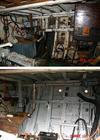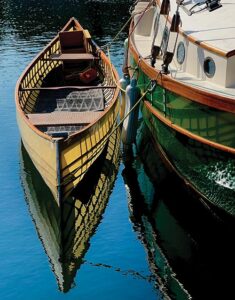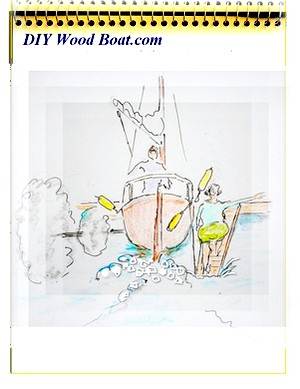- Home
- Boat Care
- Boat Varnish
- Winterizing
Winterizing Your Wooden Boat.
The term Winterizing unfortunately suggests putting your boat away and forgetting about her until spring.
That is not appropriate for plastic boats, even less so for a proper, wooden boat.
A Wooden Boat is not just for Summer

Making a list
The top item on your list of stuff to do should be, a commitment to visit her regularly.
Having a check list of To Do's can help to make sure you do not forget anything and keep the list until spring will help you remember anything that needs to be undone.
What you put on your list will, clearly depend on your boat, what equipment she has and how and where she remains for the winter months.
As I have already mentioned top of the list should be a commitment to drop in to see her as regularly as possible.
And if you take your list with you each time you call, the 'winterizing' can be spread over these visits making the process less of a chore.
Just going on board to potter about, doing a few jobs at a time, will be much more relaxing and enjoyable than trying to get it all done at once.
The added benefit being that as you enjoy her company, opening her up will allow the air to circulate.
Security
Winter
in the temperate zones may not be the best time for boating,
however it is bonanza time for boat-bit thieves.
Among the most common items stolen from boats over the winter are,
outboards, electronics and even outdrives.
The best way to avoid thefts is to remove anything which might tempt an
opportunist thief, if you cannot remove it, lock it.
Adding a personalized marking to equipment will not only help to identify and recover stolen items but will also make them less “marketable”.
A boat which looks neglected, especially if it has a 'For Sale' notice, is seen by some as almost an invitation to 'borrow', another reason why those regular winterizing visits to your boat can be beneficial.
Even fenders can be tempting but they should also be removed to stop them scuffing the topsides as they swing in the wind.
Do not forget the four-legged type of 'stowaway', who might decide to use your boat as a winter retreat, block off any entrances.
And for goodness sake do not leave a ladder affixed to the boat.
Covers
A canvas cover
will keep a boat protected and looking good indefinitely.
It will protect her from the rain, sun, bird droppings, leaves and twigs.
However you must allow the boat to breathe.
Shrink-wrap is a positive no, no.
I can not even believe that anyone would use shrink-wrap to winterize a plastic boat, on a wooden boat it is a recipe for disaster.
If you wrap her tightly in plastic she is almost sure to become damp with condensation, encouraging rot to develop.
Although reinforced plastic can be used as a cover, breathable canvas will allow moisture to evaporate when it is dry and the canvas will tighten up when it is wet to become water repellent.
The ends must be kept open so air can circulate and moisture escape.
And keep the cover in good shape, repair tears, rips and worn spots before they allow too much damp to damage the boat.
The cover should be held in place with lines from grommets in the edge of the cover but these should be anchored to the ground and not to the boat or chocks .
If there is a windstorm it is better that the cover blows away than the boat is blown over.
The tie-downs are unlikely to remain tight all winter, so this is something else to check on your regular visits.
The cover should be kept clear of the wood using a framework, which will also help to prevent water from pooling and if possible allow access to the boat under the cover.
The winterizing frame can be a simple wooden affair providing that there are no sharp corners to chaff through the cover.
Another option for frame material is PVC tubing.
It can be bought at any home improvement store, can be cut to length, bent and comes with a variety of junction, joining and clamping systems.
Custom made covers are more expensive but can be cost effective.
If they fit tightly and have robust tie downs and fasteners this will prevent flapping and reduce windage.
However, they will need to have adequate vents built in to prevent a build up of condensation and subsequent mold and mildew.
affiliate linksExterior
Wooden boats that remain afloat in salt water will tend to have less
rot
than boats in fresh water.
However, the majority of small boats are winterized out of the water.
Boats stored on the beach or yard, even during the season should be propped up on blocks so that they are off the ground at least a few inches.
And cover her so as to keep the worst of the weather off, yet still
allow air to circulate.
Try to keep her away from any shedding trees or where there is tall,
wet grass that may come into contact with the wood.
And avoid keeping her close to an old wooden shed which might be a
breading ground for rot spores.
Whether she is on blocks or on a trailer keep one end raised up to help
shed rainwater.
Open the drain plug, if there is one, to allow any bilge water to drain.
On the other hand if you are keeping you boat indoors in a garage or
shed, be careful that the wood isn’t allowed to dry excessively.
Wherever you keep her, check her periodically and allow the air to circulate through the interior.
It can be argued that a hull which is well protected with paint and
varnish is better off without a cover.
However, varnish
and paint
will degrade more quickly when exposed.
No matter how thorough your initial winterizing, a wooden boat left to stagnate is an ideal breeding ground for those rots spores.
While you should keep her clean at all times, it is doubly important
when winterizing, as dirt will retain moisture.
And clean off any barnacles or other marine growth especially off props
and shafts, rudders, struts and trim tabs.
Clean all through
hull fittings and their strainers.
Open seacocks
to allow any water to drain.
Give everything a good old scrub, not just the hull and deck but all
the hardware, the mast and the rigging, to remove salt and grime.
Touch up any damaged varnish or paintwork and check for any cracks or
plywood delamination and repair if required.
Fill any splits or cracks now, not only to reduce water damage
and rot
but because if that water freezes it will expand and widen the cracks.
And while you are checking, have a look at the steering gear, if
anything needs repairing best find it now rather than on the spring
launch day.
Now is also a good time to check and service all the standing rigging
and associated bits and pieces.
Cam cleats, rope clutches, roller furling systems, sheet tracks and
cars can all be flush through with clean water and greased where
necessary.
It is also a good time to service all winches and capstans.
Interior
Make sure the bilges are clean and dry, and clean up any oil spills.
Completely drain all water systems such as fresh water tanks, the heads and any holding tanks.
You
might also want to flush some chlorine solution around the fresh
water system and a mild non-toxic antifreeze around the others.
Clean all drawers
and lockers, prop open the doors to allow the air to
circulate.
Cushions can be turned up on edge to allow air to circulate around
them, better still take them home and store in the dry.
The same goes for things like life jackets, sails, clothing etc.
There are several commercially available odour and moisture absorbing
products available but good old vinegar
is ideal for killing and
preventing mildew.
However, there is no substitute for good ventilation,
which is
why shrink-wrap is such a lousy idea and why even with a canvas cover
it should not be closed at the ends.
And don’t forget to remove propane/butane gas bottles from the boat, and burn off any residue in the pipes.
affiliate linksSails and Rigging
Any rigging left aloft over the winter will be subject to
constant wear
as it fraps in the wind, especially those halyards chafing against the
mast.
Take your sails and running rigging home.
Halyards can be withdrawn by tying a ‘messenger’ or ‘mousing’ line to
the end of each as you pull them through, so that they can easily be
replaced in the spring.
All rope
halyards and other lines should be soaked in a bucket of warm
soapy water to get any salt san or other grit out and keep them supple.
And the same goes for your sails.
Scrub each sail in a mild detergent, dry it carefully then refold it
and store in a dry place, preferably one where flies and rodents cannot
get in.
While you are washing them is a good time to check for any problems.
And don’t forget the sail covers.
Blocks will also benefit from a flush through with fresh water or mild detergent.
Engine
The engine is probably the most expensive single item on your
boat.
So, while servicing and winterizing it can be a messy job it shouldn’t
be put off.
If your boat remains in the water for the winter, run the engine regularly.
Running
the engine every time you visit will not only charge the
batteries but also get the oil circulating and help to get rid of any
condensation that will have accumulated in the sump.
However, whether she in or out of the water change the oil and filter
as you don’t want that dirty oil stagnating in the engine.
If she is out of the water then as well as changing the oil you should
winterize the engine fully.
Start by removing the batteries to a warm dry place, charge them fully
and recharge every month or so.
Then drain the engine’s cooling system completely.
If it’s a closed cooling system, add the recommended antifreeze and
water solution according to the manufacturer’s guidelines.
If it’s an open system, flush through with clean water.
On your regular visits turn the engine over by hand, this will help circulate the oil and also hep prevent the impeller becoming ‘set’.
Keeping the fuel tank topped up will leave less room in the tank for condensation to form.
And you might want to add an additive to prevent the dreaded diesel bug.
There are numerous other winterizing precautions which will depend on the type and model of your engine.
Refer to your engine manufacturer's guide for the full winterizing check list.
affiliate linksWinterizing the Trailer
Oh, and do not forget to winterize your boat trailer , it needs looking after too.
Rinsing off any salt water and keeping the paint touched up will prevent rust.
And do not forget to flush the bearings with fresh water and then grease with a marine grease.
This might all seem like a lot of work but much of it can be done piecemeal over the winter months.
So, make that list, tick off the jobs done and keep the list to remind you of anything that needs to be undone come the spring.
Having winterizing her properly she will return the care tenfold, come springtime.
Previous posts
See What Others Have Posted
Preparing bare wooden hull and topsides for winter storage
I have just sanded all the paint off the bottom and topsides of my wooden catboat.
So I'm down to the bare wood.
I will store the boat outside …
Mold
FACT: BLEACH KILLS FUNGIS
FACT: PEROXIDE KILLS MOLD. SO WILL COMMERCIAL O2 MACHINES, BUT DO NOT USE THEM WHILE ABOARD. VERY HARD ON YOUR LUNGS!
Winter Lift Out
Is there a generally accepted minimum amount of time that a 1960's classic wooden yacht should be lifted out of the water to dry out?
She's berthed …
Wood Boat Winterizing
Does anyone know where I could find some informative material on how to winterize my 1962 30 foot Owens Empress Cruiser?
It has twin 283 engines and …




















